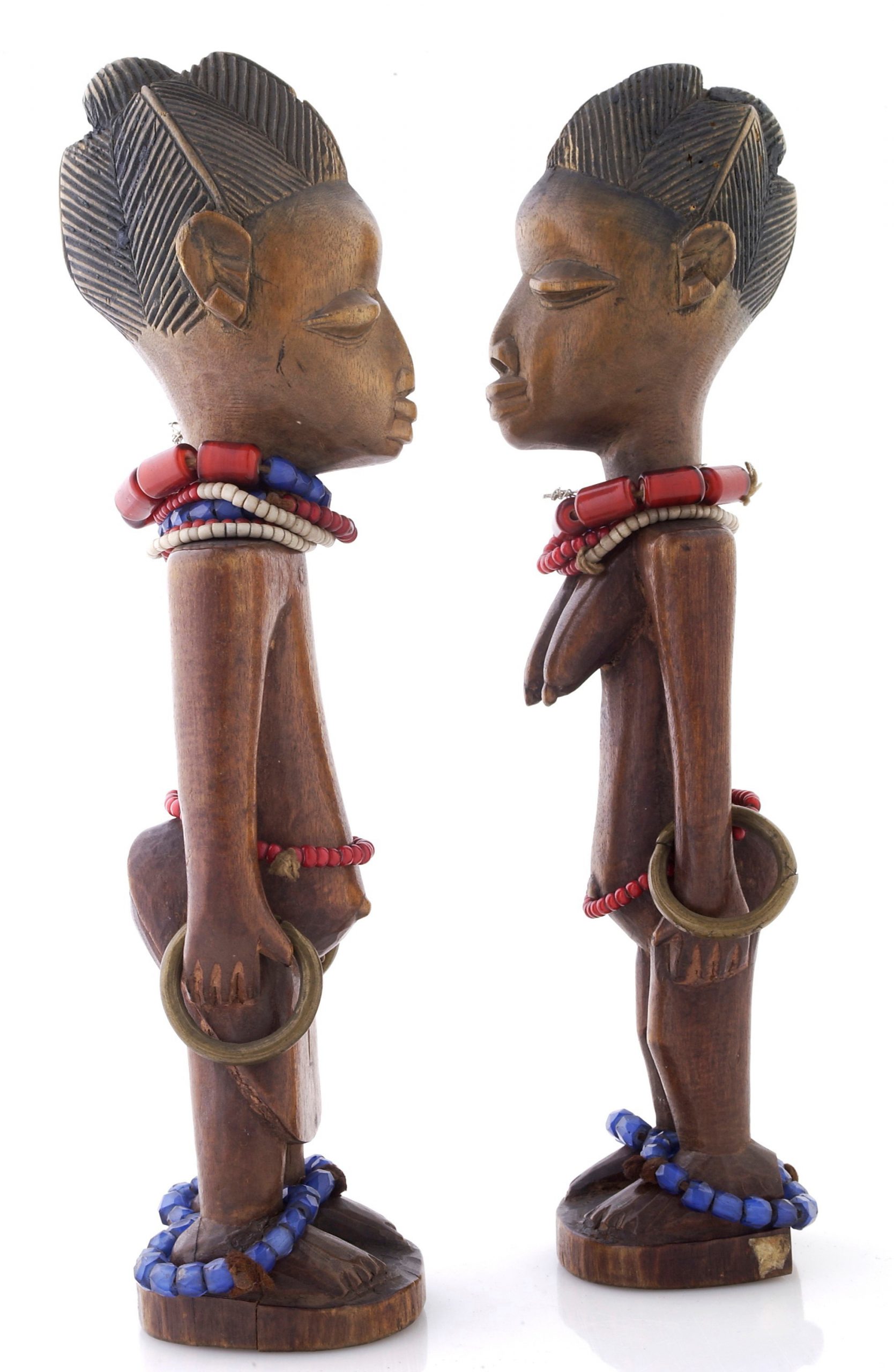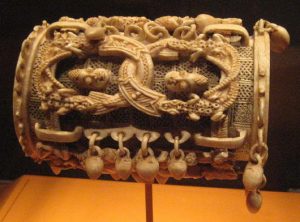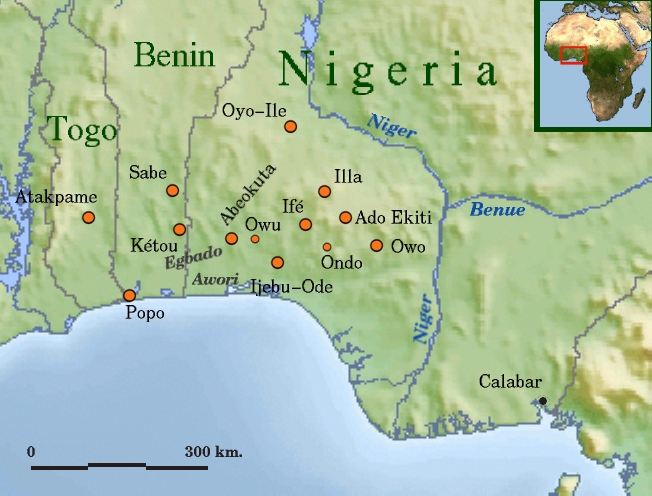26 The Yoruba

circa 1300 CE; copper; height: 29.2 cm;
discovered at Ife; Ife Museum of Antiquities (Ife, Nigeria)
Africa covers around 6% of the earth’s surface and has 54 countries. The approximate population on the continent numbers around 1.3 billion people. There are well over 3000 different ethnic groups in Africa, each with their own history, language and set of beliefs and practices. These frequently co-exist alongside the religions of Islam, Judaism and Christianity, which also have long histories in various African nations. The relationship between the Abrahamic religions and the native beliefs and practices can be difficult at times, and the more conservative of the branches of those three religions has attempted to eradicate the practices of the Yoruba.
History and Belief
With help from Janet Topp Fargion[5]:
Indigenous African beliefs frequently include the worship of various spirits, multiple gods, family and tribal ancestors, and are based on an understanding that the spiritual infuses every aspect of daily life. The concept of a supreme being is not always a part of indigenous tribal life and practice, and the gods, ancestors and spirits are not necessarily thought to be omnipresent, omniscient, or even always good.
The role of ancestors is important within these traditions, indicating a link between the dead and their living descendants. Diviners, priests or community members communicate with the dead in various ways, and this might include prayers, sacrifices, rituals, festivals and ceremonies. In most parts of West Africa, public festivals and masquerades are central to spiritual wellbeing. The masks worn at these events embody gods and spirits who dance, sing or speak in ways that identify them to the participating community.
The Yoruba are one of Africa’s largest ethnic groups with more than twenty-five million living in Nigeria, the Republic in Benin, and Togo. Its pre-modern history is based largely on oral traditions and legends. Ile Ife is the city where the Yoruba believe their civilization began as well as the location where they say that the gods descended to earth. Oral tradition and historical reality do not completely match, but the story is longstanding. Ile Ife came to be a city in about 500 BCE. It is considered to be the origin of all African people by the Yoruba.
The meaning of the word “ife” in Yoruba is “expansion.” “Ile-Ife” is therefore in reference to the myth of origin, “The Land of Expansion.”

The creation story of the Yoruba is seen below.
Besides being central in the history of the Yoruba people, Ife is also famous for its art. From terracotta sculptures to stones and bronze sculptures that can still be found in museums, the art of the Yoruba is becoming world famous.
The Yoruba have hundreds of deities. Yoruba deities are called orisha, and the high god is Olorun. Other important orishas include Eshu, the trickster; Shango, the god of thunder; and Ogun, the god of iron and modern technology.
The Yoruba believe that the ancestors still have real influence among the living. Annual ritual honor is paid to the family or clan ancestors, and this yearly sacrificial activity honors all deceased members of the family. Egungun (maskers) appear at funerals and are believed to embody the spirit of the deceased person.
Lecture: More information on Yoruba history and culture from Professor Toyin Falola [6]
Location
Yoruba people are concentrated in the southwestern part of the country of Nigeria, in Benin and northern Togo. The Yoruba number more than 35-40 million across Africa. There is a long and rich history of the various people who became the Yoruba. They originally called themselves the Oyo.
The term Yoruba (or Yariba) did not come into use until the nineteenth century, and was originally confined to subjects of the Oyo Empire. The term Yoruba did not always designate an ethnicity and usually described those who spoke the Yoruba language. The first documented use of the term Yoruba as an ethnic description comes from a scholar in the sixteenth century.
The empire of Oyo arose at the end of the 15th century CE. Expansion of the kingdom of the Oyo is usually associated with the people’s increased use of horses. At the end of the 18th century CE civil war took place within the Oyo empire, and the rebels against the old order turned to the Fulani for help. Instead of helping, the Fulani ended up conquering the Oyo empire in the 1830s. In the late 1880s, with the help of a British mediator, a treaty was signed. Yoruba lands were officially colonized by the British in 1901. Nigeria became an official colony in 1914. But on October 1, 1960 Nigeria was declared independent of British rule.
Lifestyle
The Yoruba were historically primarily farmers, growing cassava, maize, cotton, beans and peanuts. The Yoruba are also known for their fine crafts. Traditionally,

Owo region in Nigeria. Now in the National
Museum of African Art, Washington DC.
they worked at such trades as blacksmithing, leatherworking, weaving, glassmaking, and both ivory and wood carving.
Each town has an Oba (leader), and every Oba is considered to be a direct descendant of the founding Oba of that city even if that cannot be proved through written records. A council of chiefs usually assists the Oba.
An excellent and thorough look at Yoruba and Nigerian culture and lifestyle can be found at Yoruba Art and Culture: Phoebe Hearst Museum of Anthropology
Ritual
Performances of an Egungun (representative of ancestral spirits visiting the living),
Epa (symbolic performances variously promoting valor and fertility), and
Ẹyọ, a procession of masked dancers.
“Art has often been inspired by spiritual beliefs. For the Yoruba, art and spirituality are often intertwined. Works of art give visual form to the divine and inspire religious devotion. In turn, they are made powerful by spiritual forces. Aesthetics play an important role in the manifestation of the sacred. As the Yoruba say, art has the power to fa ajú móra (magnetize the eyes), becoming àwòwò–tún–wò (that which compels repeated gaze).”[7]
In Nigeria there are many gods (òrìṣàs) who are worshipped. Prior to the Gẹ̀lẹ̀dẹ́ masquerade festival, members of the community consult priests, who then communicate with the òrìṣàs. The priest throws sets of palm nuts and draws symbols on a board, interpreting the words of the òrìṣàs for the community.
The film below includes extracts from a documentary on the Gẹ̀lẹ̀dẹ́ masquerade, performed by the Yoruba people of Nigeria. It shows preparations for the masquerade, including people consulting the Ifá priest, who helps to communicate with the spirits and decide which songs will be sung during the ritual. The Gẹ̀lẹ̀dẹ́ is performed to pay tribute to the role women play in the organization and development of Yoruba society. The songs tell of the power of the Great Mother. The film was made by Peggy Harper and Frank Speed in the 1960s.”[8]
Example: preparation for a masquerade
Some of these West African practices were transported with enslaved individuals across the Atlantic Ocean in the 16th and 17th centuries. Brazilian candomblé, an extension of some of the Yoruba beliefs, is testament to the strength of the practices as they continue in these settings to the present day. Caribbean Vodou also carries in its beliefs and practices ideas found here about the role of spirits in human lives.
In some instances leaders or community members enter a ‘trance-like’ state. Some communities interpret this as possession, believing that a spirit takes control of the person in a trance. It is often interpreted as the practitioner making contact with the spirit or an ancestor and then relaying what is said by one of these spirits or ancestors back to the community.
The Yoruba Gẹlẹdẹ from the Ketu region of the modern Republic of Benin received the honor of being recognized as a Masterpiece of the Oral and Intangible Heritage of Humanity by UNESCO.
“YORUBA Creation Myth.” The Big Myth, 25 June 2020, youtu.be/6BMLUdU4gwQ.
Nolte, Insa (2015). ‘Histories of religion and the word’ in West Africa: Word, Symbol, Song edited by Gus Casely-Hayford, Janet Topp Fargion and Marion Wallace. British Library.
“The Yoruba from Prehistory to the Present.” Cambridge University Press, 21 Oct. 2020, youtu.be/fRy92OJCtcY.
“Yoruba – Art & Life in Africa – the University of Iowa Museum of Art.” Art & Life in Africa – The University of Iowa Stanley Museum of Art, 2021, africa.uima.uiowa.edu/peoples/show/Yoruba.
Mullen, Nicole. Yoruba Art and Culture. PHOEBE A. HEARST MUSEUM OF ANTHROPOLOGY, 2004, hearstmuseum.berkeley.edu/wp-content/uploads/TeachingKit_YorubaArtAndCulture.pdf.
Egu, Ken Chiedozie. “Ile IFE, Nigeria (Ca. 500 B.C.E.- ) •.” •Black Past, 16 Dec. 2020, www.blackpast.org/global-african-history/ile-ife-ca-500-b-c-e/.
Fargion, Janet Topp. “African Belief Systems.” British Library, Discovering Sacred Texts, 2021, www.bl.uk/sacred-texts/articles/african-belief-systems.
Boundless World History. Located at: https://www.boundless.com/world-history/textbooks/boundless-world-history-textbook/. License: CC BY-SA: Attribution-ShareAlike


